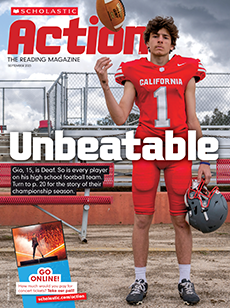N1: A teenager named Pam sits on a swing in her grandmother’s yard. She looks out at the gray sky.
N2: Her grandmother walks up behind her.
Grandma: You know, staring at storm clouds all the time won’t make you feel better.
Pam: I miss home. I miss Dad.
N3: Grandma frowns.
Grandma: I’m sorry, honey. It just made sense to move here for a bit. I can help your mom while your dad is deployed.
Pam: I know, Grams.
Grandma: Why don’t you come in for a snack?
Pam: I need some time to think. I’ll be in soon.
N1: Grandma walks back to the house.
N2: About a minute later, Pam looks up. She sees a large, dark cloud in the distance.
N3: Lightning flashes across the sky.
Pam: Wow, this looks like some storm. I need to get my video camera!
N1: Pam runs inside. She grabs the camera her dad gave her before he left.
N2: Back outside, the wind is whipping. Pam starts to film.
N3: The dark cloud spins into a funnel.
N1: It destroys a barn in the distance.
Mom: Pam! Inside—NOW!
N2: Pam turns and runs. Dirt and dust fly through the air, making it hard to see.
Mom: Pam! Where are you? To the cellar!
N3: Pam struggles against the wind. Finally, she makes it to the cellar door. Her mom pulls her inside.
Grandma: Pam! Thank goodness.
N1: The house shakes. A roar fills the room.
Pam: What’s happening?
N2: Pam closes her eyes. Her mom holds her tight.
N3: After a few minutes, the shaking stops.
N1: Pam and her mom and grandma slowly make their way outside.
N2: They look up at their home.
Mom: I can’t believe it!
N3: Grandma’s house hardly has any damage.
N1: But the neighbors aren’t as lucky.
Grandma: Oh no. The Donohues’ house . . .
N2: Pam looks to her right. An older couple is standing on the curb, in shock. Their house has been destroyed.
Mom: I’m going to make sure they’re OK.
N3: Sirens can be heard in the distance.
